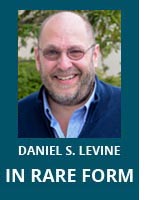 It was many years ago that my wife and I went away for a Valentine’s day weekend. It began with a long drive after a full day’s work. When she went to the bathroom to brush her teeth before getting into bed, I took out the bouquet of flowers I had bought for her, got on top of the blankets in my naked splendor, and strategically placed them where I figured her eyes would go.
It was many years ago that my wife and I went away for a Valentine’s day weekend. It began with a long drive after a full day’s work. When she went to the bathroom to brush her teeth before getting into bed, I took out the bouquet of flowers I had bought for her, got on top of the blankets in my naked splendor, and strategically placed them where I figured her eyes would go.
She got under the covers, said “goodnight,” and rolled on her side to go to sleep.
It was because of that experience that I wasn’t surprised to read of a new study published in the Proceedings of the National Academy of Sciences of a man with a rare neurodegenerative disorder that suggests seeing can happen independent of awareness.
The study by researchers at Johns Hopkins University centered on an engineering geologist they simply identify as RFS. RFS had a rare condition that resulted in him being unable to visually process the numbers two through nine.
In 2010, RFS was 60 years old when he suffered an acute neurological event. He suffered headaches, temporary loss of vision, episodic loss of the ability to speak or understand speech, and amnesia. His condition continued to progress over the next several years and he began to experience a range of motor, sensory, and muscle problems including difficulty walking. MRIs revealed volume loss in his brain that suggested a rare condition known as corticobasal degeneration.
In addition to symptoms including problems with his memory and muscle spasms, RFS lost the ability to see the number two through nine. When shown a number, he saw what he called a cluster of squiggly, spaghetti-like lines. His vision was otherwise unaffected and he was able to read letters and other symbols. The research tried to determine why his brain only had trouble seeing numbers or things near them.
For instance, he could not see an object if it were placed on top of a digit. When the researcher showed him the number “3” with a picture of a violin on top of it, he was unable to see the violin. However, if the violin was far enough away from the “3,” he was able to see it.
“When he looks at a digit, his brain has to see that it is a digit before he cannot see it. It’s a real paradox,” said Michael McCloskey, senior author and a professor in the department of Cognitive Science at Johns Hopkins University. “In this paper what we did was to try to investigate what processing went on outside his awareness.”
The researchers used an electroencephalography, a device used to measure the electrical activity in different parts of the brain, to test RFS as he viewed different things. When RFS was shown a face embedded on a number, the brain activity as measured by the electroencephalography indicated he saw it, even though he was unaware of it. The measurements were the same when he was shown the face by itself.
The researchers also tested his ability to see words embedded on numbers. He was unaware that a word was there, even though electroencephalography indicated his brain was recognizing the words.
What the scientist found was that even though his brain was doing complex processing to see the numbers, it happened independently of awareness.
The study suggests that it is possible to see something without being aware that you are seeing it. Put another way, the complex processing in the brain that takes place when we see something by itself doesn’t provide awareness that we are actually seeing that something—that there is additional processing necessary.
Though it is often difficult for doctors and researchers to diagnose a patient with a rare disease, these conditions can provide not only an understanding of more common diseases, but also insights into the complex workings of the body.
Image: The image shows the number 8 as it was shown to RFS and a drawing he made of what he saw.

Stay Connected
Sign up for updates straight to your inbox.
